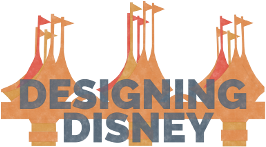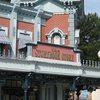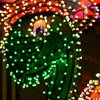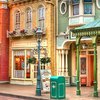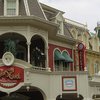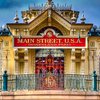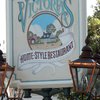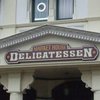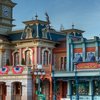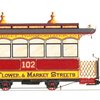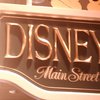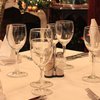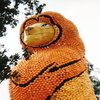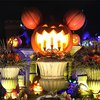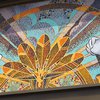Designing Main Street USA - Casey's Corner
The outlook wasn't brilliant for the Mudville nine that day; The score stood four to two with but one inning more to play. And then when Cooney died at first, and Barrows did the same, A sickly silence fell upon the patrons of the game. A straggling few got up to go in deep despair. The rest Clung to that hope which springs eternal in the human breast; They thought if only Casey could but get a whack at that -- We'd put up even money now with Casey at the bat.
Located at the left hand side of Main Street right on Disneyland Paris Hub, Casey's Corner offers guests a wide range of delicious, meant-to-be fast dishes in sport-themed surroundings. For Walt Disney Imagineering, Baseball, America's favorite past time at the end of the 19th century, seemed the perfect match for a restaurant where hotdogs, soda and french fries are served. After all, this type of food is traditionally sold at baseball games in the States. The graphic design, costumes and imagery of baseball was so beautiful that Eddie Sotto and its team felt that anyone could enjoy it.

According to mister Sotto, the imagery of Casey is derived from the Disney short cartoon called 'Casey at the bat' (released August 15, 1946 by RKO Radio Pictures, Inc., directed by Jack Kinney). This is the Disney version of the homonymous poem by Ernest L. Thayer. This timeless original poem was first published in the San Francisco Examiner on June 3, 1888. It tells the tale of "mighty" / popular Casey of the Mudville nine, who steps up to bat and strikes out during the crucial moment of a baseball game. The text is filled with references to baseball (f.e. the involvement of the crowd) as it was in 1888.




The exterior of the Casey's Corner building is marked with the large letter C sign similar to the logo of the Cincinnati Reds baseball club.


A carved figure of Casey can be found near the front door. It is reminiscent of what used to be called "Cigar Store Indians". The cigar store Indian or wooden Indian is an advertisement figure made to represent tobacconists. Because of the general illiteracy of the populace, early tobacco store owners used descriptive emblems or figures to advertise their shops' wares. The figure of an Indian was chosen because Indians introduced tobacco to Europeans. Relying on its own experiences at Knotts Berry Farm theme park (Buena Park California), mister Sotto thought the static Casey figure would make a great opportunity for guests to pose for an unforgettable picture.


If you're sitting outside of Casey's you might notice one of the upstairs windows is dedicated to the two men who wrote the song 'take me to the ball-game'. This early-20th century song is written by Jack Norworth. The words were set to music by Albert Von Tilzer. The song is traditionally sung during the seventh-inning stretch of a baseball game. Fans are encouraged to sing along.

While entering the building, you may notice the Casey's Corner advertisement poster drawn by Jim Michelson. This Walt Disney Imagineering artist was responsible for many of the other Disneyland Paris Main Street USA posters (f.e. The Gibson Girl Ice Cream Parlor, a Main Street USA building which will be discussed in one of the upcoming posts). The Casey's poster is based on a cover illustration of one of the Spalding Baseball Guides (see comparative study below).


Spalding's Official Base Ball Guide was an annual baseball guide, founded by A. G. Spalding, and published by his American Sports Publishing Company. It featured editorials from baseball writers on the state of the game, statistics, photographs, and analysis of the previous season for all the Major League teams and for many of the so-called minor leagues across the nation. Some of its editions can be read online.
The dining hall of the Casey's Corner Restaurant is lavishly decorated with loads of vintage baseball and Coca Cola memorabilia.

A lot of Coca Cola artifacts found within Casey's were exclusively reproduced for the Euro Disneyland project after historic images found in the archives of the Coca Cola Company in Atlanta. One of them are the Coke light fixtures (manufactured in the tradition of Louis Tiffany) which were once provided to American drugstores for promotional use.
The walls in the back room (which are all painted red) are covered with a deeply embossed wall covering called 'Lincrusta'. A British invention, it was the brainchild of manufacturer Frederick Walton whose father pioneered linoleum floor covering in the 1860's. Lincrusta was launched in 1877 to instant success in a host of applications from royal homes to railway carriages. Due to its popularity at the end of the 19th century, Imagineer Eddie Sotto used this surface in many ways throughout Main Street USA.

In the same room, a xylophone of Coca Cola bottles can be admired. Mister Sotto once told he dreamt of a kind of 'scoreboard' above Casey's counter which would show visitors how much Coca Cola's had been sold through the day as traditionally these locations sell more Coca Cola than anywhere in the world. Due to technical issues, the idea had to be abandoned.

Americans can experience the magic of Casey's Corner too. Walt Disney World's Coke Corner adopted the Casey's theme in the mid nineties.


Credits
Photos:
- Imagineering My Way
- Dolce Danielle
- Tom Bricker
- Robbix
